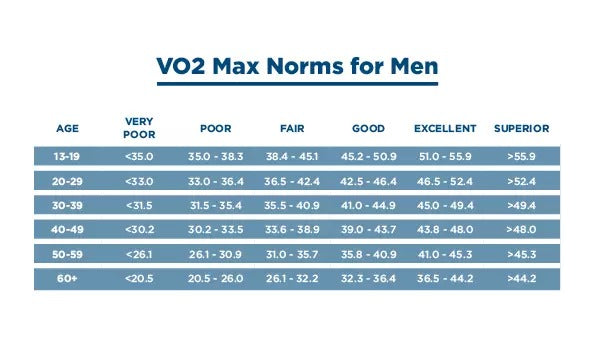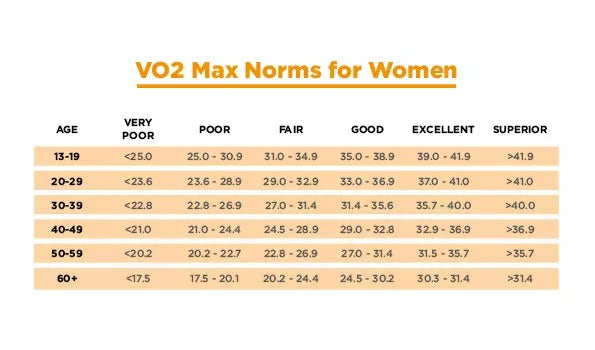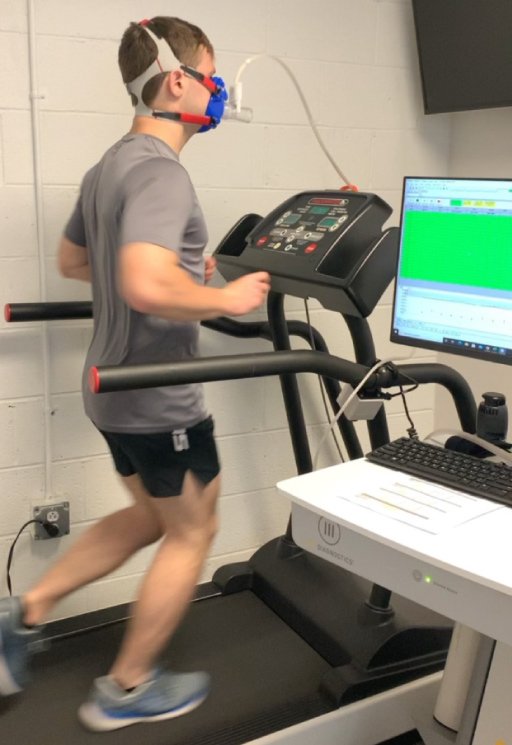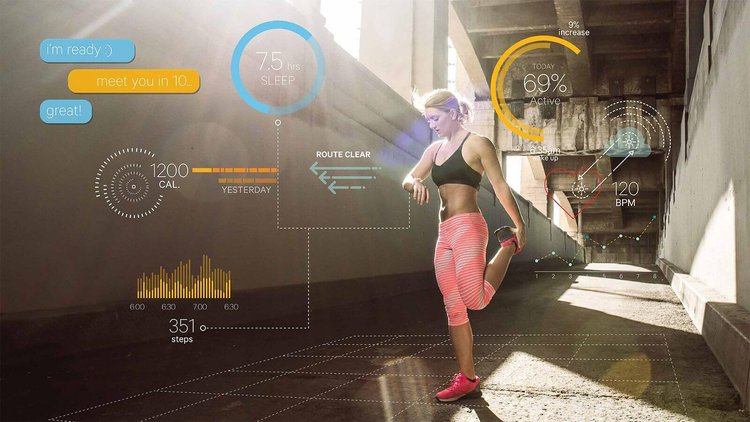VO2 Max: Test Your Potential and Train Smarter
What is VO2 Max?
- Global Indicator of Cardiovascular Health: VO2 max reflects the body's maximum capacity to use oxygen during exercise, making it a key indicator of cardiovascular and respiratory health. A high VO2 max value suggests a more efficient cardiovascular system and better endurance capacity.
- Powerful Predictor of Mortality: Studies have shown that VO2 max is an independent and powerful predictor of all-cause mortality. Individuals with higher VO2 max levels generally have a significantly lower risk of mortality.
- Indicator of Biological Age: VO2 max is considered a good indicator of a person's physiological age. A high value suggests a "biological age" that is younger, regardless of chronological age.
- Reflection of Mitochondrial Health: VO2 max is strongly correlated with the health of mitochondria, the "powerhouses" of our cells. Better mitochondrial function is associated with healthier aging.
- Marker of Functional Capacity: A high VO2 max is linked to better functional capacity, which is crucial for maintaining independence and quality of life as we age.
- Reversibility of Age-Related Decline: Although VO2 max naturally declines with age, this decrease can be slowed or even reversed through regular exercise. This offers an opportunity for interventions to improve longevity.
It is important to note that while VO2 max is an excellent predictor of longevity, recent research suggests that this is not necessarily a direct causal relationship. Improving VO2 max through regular exercise is nonetheless beneficial for overall health and longevity.
Measure your Vo2Max at Maison Epigenetic, and improve it with Vasper , Synchronized Cardio Pressotherapy and the Longevity Lab
VO2 Max performance test
VO2 max values vary significantly between individuals based on factors such as age, sex, fitness level, and genetics. However, here are some general ranges and averages for VO2 max in men and women.
It is important to note that men generally have higher VO2 max values than women due to differences in body composition, with men typically having more lean muscle mass and less body fat.
4o
VO2 Max Ranges - Men
| Category | VO2 Max (mL/kg/min) |
|---|---|
| Average untrained man | 35-40 |
| Good level of physical fitness | 43-52 |
| Excellent level of physical fitness | >55 |
| Elite Male Athletes | 70-85 |
VO2 Max Ranges - Women
| Category | VO2 Max (mL/kg/min) |
|---|---|
| Average untrained woman | 27-31 |
| Good level of physical fitness | 35-43 |
| Excellent level of physical fitness | >46 |
| Elite female athletes | 60-75 |
Age-related differences - Men
| Age | VO2 Max “good” (mL/kg/min) |
|---|---|
| 20-29 years old | 49-56 |
| 30-39 years old | 48-56 |
| 40-49 years old | 43-51 |
| 50-59 years old | 39-45 |
| 60 years and over | 36-41 |
Age-related differences - Women
| Age | VO2 Max “good” (mL/kg/min) |
|---|---|
| 20-29 years old | 43-52 |
| 30-39 years old | 42-45 |
| 40-49 years old | 38-41 |
| 50-59 years old | 34-37 |
| 60 years and over | 32-35 |
Elite athletes
| Discipline | VO2 Max (mL/kg/min) |
|---|---|
| Male cross-country skiers | Up to 96 |
| Women's cross-country skiers | Up to 80 |


TO EFFECTIVELY INCREASE YOUR VO2 MAX, HERE ARE THE BEST TYPES OF RECOMMENDED EXERCISES
For optimal results, it is recommended to combine:
• 2-3 HIIT or interval training sessions per week
• Basic endurance sessions
• Strength and flexibility work
It is important to progress gradually, starting with shorter, less intense sessions and then gradually increasing volume and intensity over 8 to 12 weeks.
Interval training
Similar to HIIT, interval training is particularly effective for increasing VO2 max. It can include:
• Series of 30 seconds of intense effort followed by 30 seconds of recovery
• 3-5 minute high intensity intervals for more experienced athletes
Basic Endurance Exercises
Although less effective than HIIT, long-duration, moderate-intensity endurance exercises also help improve VO2 max:
• 60-90 minute run at a comfortable pace
• 2-3 hour bike rides at a moderate pace
• 1.5-3 km swim at moderate pace
Hill training
Incorporating hill workouts can increase intensity and further boost aerobic capacity.
How is a VO2max test carried out?
- You will wear a heart rate monitor and a face mask.
- The mask is connected to our medical grade metabolic cart (the same one used by the Mayo Clinic).
- You will start by walking on the treadmill or cycling to warm up. We will gradually increase your intensity over a period of 10 to 20 minutes.
- You will receive a consultation to review your results and ask any questions you may have.
Physiological factors of decline
Cardiovascular system
• Decreased maximum cardiac output
• Reduction in maximum heart rate
• Decrease in stroke volume
• Decreased elasticity of blood vessels
Muscular system
• Loss of muscle mass (sarcopenia)
• Reduction of the oxidative capacity of muscles
• Decreased mitochondrial density
• Decreased muscle enzyme activity
Respiratory system
• Decreased lung elasticity
• Increased rigidity of the rib cage
• Reduced pulmonary diffusion capacity
Impact on performance
• The ability to maintain intense efforts decreases
• Recovery time after exercise increases
• Endurance performance gradually declines
Individual variability
• The rate of decline varies considerably between individuals
• Active and fit people generally experience a slower decline
• Endurance athletes maintain higher VO2max values than their sedentary peers, despite age-related decline
Health implications
• Decreased VO2max is associated with increased risk of cardiovascular disease and mortality
• Maintaining a high VO2max is linked to better quality of life and greater functional independence with age
Strategies to mitigate decline
• Regular exercise, especially endurance training, can slow the decline in VO2max
• High-intensity interval training (HIIT) has been shown to be particularly effective in maintaining and even improving VO2max in older adults
• Maintaining an active lifestyle throughout life is crucial to preserve aerobic capacity

How is VO2 Max measured?
A specialist will help you put on a face mask, which is connected to a metabolic cart. You will then complete a series of incremental exercises to determine your VO2 Max.
A metabolic cart detects near-breath measurements, such as oxygen (O2) and carbon dioxide (CO2), using indirect calorimetry. Indirect calorimetry is a technique that measures inspired and expired gas flows, volumes and concentrations of O2 and CO2.
When you breathe, the air is collected in a mixing chamber where the gas is analyzed. We use a scientifically reliable and valid metabolic cart for indirect calorimetry testing.
As air enters the chamber, the volume of air and the ratio of carbon dioxide to oxygen are measured. The testing system uses specialized software, which can determine the energy expenditure of exercise.
At Maison Epigenetic, we can monitor your breath measurements in 15-second intervals for the duration of the test. This allows our exercise physiologists to observe not only the changes that occur, but also how quickly physiological markers change as exercise intensity increases.
Bring leggings/shorts and a t-shirt. Any cancellation within 24 hours of your treatment will be due.
WHERE TO DO YOUR PHYSICAL CHECK-UP?
4 bis rue Cimarosa
75016 PARIS
01 80 97 91 71
contact@maisonepigenetic.com
Business hours :
Monday: 9 a.m. - 7 p.m.
Tuesday: 9 a.m. - 7 p.m.
Wednesday: 9 a.m. - 7 p.m.
Thursday: 9 a.m. - 7 p.m.
Friday: 9 a.m. - 7 p.m.
Saturday: 10 a.m. - 7 p.m.
Sunday: 10 a.m.-6 p.m.
Valet
Monday to Friday from 9 a.m. to 6 p.m.
in the side alley of avenue Kleber



